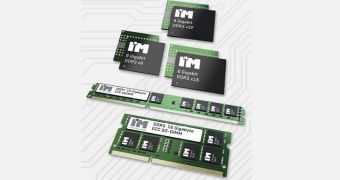Memory modules for desktops usually have the DIMM format, but if you're trying to build a server you're better off with UDIMM (unregistered memory module). Also, if it's a laptop you're looking to upgrade, SO-DIMM is best suited for you (small outline dual in-line memory module).
SO-DIMMs are also good in desktops with little internal space, like HTPCs (home-theater personal computers) and nettops. As it happens, I'M Intelligent Memory has released both UDIMM and SO-DIMM modules.
The new modules come in up to 16 GB capacity and are made from 8 Gb (Gigabit) DDR3 chips, which are the true new products released by the company.
According to the inventors, the capacity is doubled compared to other DDR3 DRAM devices. Not that these are the first 8 Gb chips ever made (the JEDEC specification JESD79-3 has always allowed for this capacity), but they don't really grow on trees either.
The new chips comply with the JEDEC standard pinout, timing and row/column/bank addressing, meaning that they can be used for any sort of system memory. I'M Intelligent just chose to start with the ones that put them to best use.
There are modules of 16 GB with 240 pins (240 Pin unbuffered DIMMs, or UDIMMs for short), as well as SO-DIMMs with 204 pins. All of them have ECC error correction with 72-bit width.
Microcontrollers from Cavium, Freescale, Tilera, Advanced Micro Devices (AMD) and other companies have been found fully compatible with the 8 Gb chips.
Moreover, Intel's Atom C2000 series (Avoton) CPUs, as well as Atom E3800 Bay Trail-I central processing units (CPUs) are fully equipped to make optimum use of them as well.
But this is where the snag is: most Intel standard desktop PC processors, as well as many CPUs that power laptops and servers, do not support high-capacity chips like these, as there is no demand on the part of consumers.
Thus, you should only look to buy a supply of 8 Gb DRAMs and/or memory kits based on them if you are going to set up a server/data center powered by one of the CPUs above. Then again, some motherboard makers like ASROck, Supermicro and AIC might have updated the BIOS'es of their platforms to make up for this perceived drawback.
For now, though, the 8 Gb memory and high-density DDR3 modules will do best in embedded, industrial, telecommunications and networking applications. The Intel Avoton-based “Tormenta Megacore Blade-System” owned by German company Rausch Netzwerktechnik will be among the first adopters, reaching 12,800 GB RAM by means of I'M Intelligent Memory 16 GB ECC SO-DIMMs.

 14 DAY TRIAL //
14 DAY TRIAL //